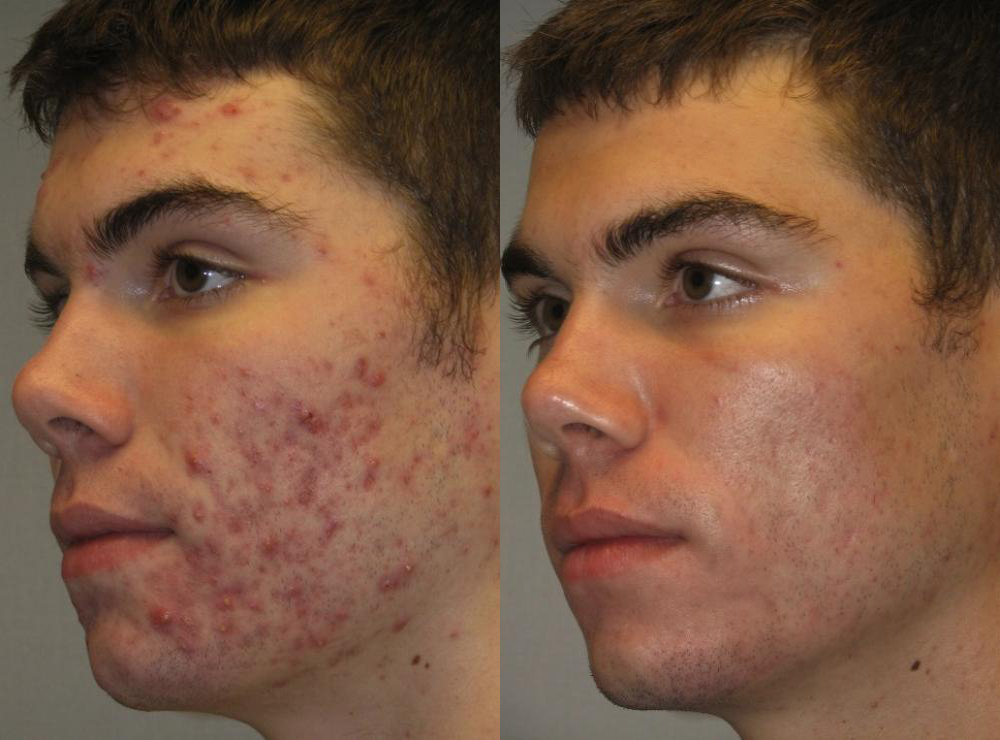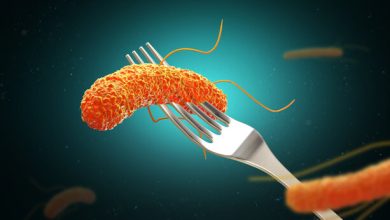Why Does Acne Appear?

Acne disease is skin changes associated with inflammation and disruption of the sebaceous glands. Most often it occurs on the face, as well as the upper back, chest, where there are most of the sebaceous glands (the so-called seborrheic zones).
There are many pores on the surface of the skin. These are the mouths of the hair follicles – the sheaths that surround the hair of the skin. The ducts of the sebaceous glands located under the skin open into the follicles. The figures below show the structure of a typical sebaceous gland.
The structure of the hair follicle: the mouth of the hair follicle (pore), opening to the surface of the skin, the sebaceous gland. The secretion of the sebaceous gland envelops the hair and comes out to the surface of the skin.
Acne Causes
Acne is a complex disorder of hair follicles and sebaceous glands. When the follicles of the sebaceous hair ducts are clogged with a “plug” from a mixture of sebum and dead skin scales, acne develops (another name is comedones).
If the follicles are open, the plugs look like blackheads on the face and are called open comedones.
Comedones are also closed (do not communicate with the skin surface). These comedones are called whiteheads.
The production of sebum under the plug of the closed sebaceous-hair duct continues and is an ideal breeding ground for bacteria, which usually live peacefully and quietly in the sebaceous glands. The rapid growth of the bacterial population leads to the development of inflammation, which can manifest itself on the skin from small pimples to huge purulent pimples.
Numerous studies show that overactive sebaceous glands are the root cause of acne.
What Leads To This?
The most common cause of acne is naturally age-related changes in hormonal balance (“hormonal surge”). Teenage acne is caused by steroid hormones, the main of which are androgens, male sex hormones that are produced not only in young people, but also in girls. Androgen levels rise sharply during puberty. Under their action, in the course of complex chemical reactions in the skin, there is a sharp increase in the number of sebocytes – secretory cells of the sebaceous gland. In fact, the number of “workers” in the sebum factory is increasing.
By provoking acne in adolescents, hormones not only increase the amount of sebum, but also change its composition, making it viscous and dense. Sebum is usually runny and acne problems do not occur even with problematic oily skin.
This is how plugs form in the ducts of the hair follicles. These are the reasons for the formation of acne. First, microcomedones are formed, of which open and closed comedones are formed. Comedone plugs block the outlet of fat and waste products of the sebaceous glands.
Having received such an excess of food, the propionic acne bacteria begin to actively multiply. These bacteria always live in the mouths of hair follicles and sebaceous glands. Normally, they do not manifest themselves in any way and only in isolated cases can they cause acne and inflammation.
The waste products of these bacteria are highly irritating when in contact with surrounding tissues. This is how inflammation develops. An ever-expanding hair follicle can rupture and form ulcers.
4 Factors Provoke Acne
There are four factors, the combined action of which are the causes of acne:
- Hyperandrogenemia stimulates the sebaceous glands
- Follicular hyperkeratosis. The outer layer of human skin is called the stratum corneum. The constant renewal of the skin is precisely due to the sloughing of the keratinized, dead skin plates of this layer. A similar process takes place in hair follicles. Follicular hyperkeratosis is an overdevelopment of the stratum corneum of the follicles, which is the cause of the appearance of acne, since not only sebum is needed for the formation of a comedone plug, but also desquamated skin scales
- Excessive secretion of fat by the sebaceous glands and follicular hyperkeratosis lead to the fact that sebum accumulates in the sebaceous gland, leading to an increase in its volume, as a result of which aseptic (without the participation of bacteria) inflammation begins in the gland
- Reproduction of Propionibacterium acnes, acne propionic bacteria. It is worth noting that acne bacteria live in the mouth of the sebaceous glands and in absolutely healthy people, along with such representatives of the skin microflora as Propionibacterium granulosum, staphylococcus bacteria Staphylococcus epidermidis, Malassezia fungi and tiny Demodex mites. All these “living creatures” are extremely rare causes of comedones in healthy people. But when the sebaceous gland is clogged with a horny plug and hyperproduction of sebum, favorable conditions are created for the reproduction of all this “normal” microflora and a purulent pimple appears.
It’s Important
Improper skin care can also lead to acne. For those who do not forget to cleanse their face every night with makeup remover cleansing balm, acne appears less often.
What Are The Internal Causes?
The testosterone – Acne Relationship
It is inherited. We genetically inherit hormones and skin reactions. Therefore, the main cause of acne at the age of 18 is also called a hereditary factor.
The likelihood of teenage pimples is higher in children of parents who have or are suffering from acne. And you should expect the development of a serious form if both parents suffered from the problem.
Of course, other causes also contribute to the answer to the question of why acne appears.
Premenstrual Acne
Since an increase in the level of steroid hormones is also observed in the last phase of the menstrual cycle, about 70% of women associate the appearance of acne with menstruation. One or two pimples before menstruation are observed even by women who do not suffer from acne. Those who are familiar with this disease often notice purulent acne before menstruation – about a week before the start. Usually on the chin.
“Hormonal” Acne
High testosterone, acne at age 18 are normal. But after 30 years it is a serious reason to examine your health in detail. As a rule, these are hormonal acne, which are associated with a violation of the production of sex hormones.
Gynecological diseases and acne in women are inextricably linked. They provoke hormonal disorders, for example, with polycystic ovaries.
Hormonal acne can also be triggered by some conditions associated with a sharp change in hormonal status. For example, during pregnancy or after an abortion.
Endocrine glands and comedones are inextricably linked: diseases of the pituitary gland, adrenal glands, male and female genital organs affect it. So, with hyperandrogenism (increased production of male hormones – androgens in women), it is also a very common disease. Therefore, in the intrigues of the causes of acne in adults, it is not enough just to visit a dermatologist. Consultation of an endocrinologist is required, and for women – a gynecologist and a series of laboratory tests.
Hyperkeratosis
Hyperkeratosis is an increase in the upper, stratum corneum, layer of the skin. Lack of vitamin A, occupational intoxication, prolonged pressure or friction of the skin, exposure to the skin of petroleum products (for example, lubricating oil) are the main causes of hyperkeratosis. Hyperkeratosis of the sebaceous glands also develops under the influence of hormones. It is he who is the cause of acne.
More advice on skin care you can find here.



